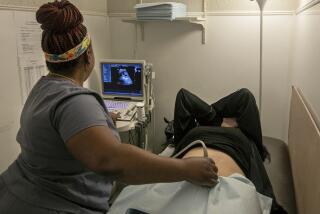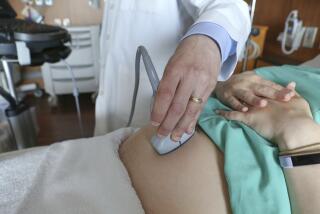Studies of Prenatal Test Cause Concern : Health: Reports linking CVS to limb deformities in babies has spooked some women--and doctors. But other experts contend the procedure is safe.
- Share via
The 42-year-old woman was about 10 weeks pregnant, and she was frightened. She wanted to cancel her chorionic villi sampling, a test performed between the ninth and 11th weeks of pregnancy to detect chromosomal defects.
Dr. John Williams III, medical director of the Prenatal Diagnostic Center in Beverly Hills, tried to reassure her that the test’s benefits outweighed any risks. But his patient was firm: No CVS.
That scene has been repeated recently in prenatal clinics and obstetricians’ offices across the country as reports surface that CVS might cause limb deformities in babies.
But according to most CVS experts, the link between the procedure and limb deformities has not been established and is creating unwarranted panic among women who have recently undergone CVS or who had planned to have the procedure.
While a few centers no longer offer the test, officials at both the National Institutes of Health and the American College of Obstetricians and Gynecologists say they still believe CVS is a safe alternative to amniocentesis. Amniocentesis, the most common of prenatal tests, is usually performed about a month later than CVS.
“It chagrins me to see a patient over the age of 40 wait for an amniocentesis because she fears a limb-reduction abnormality,” says Williams, whose center is one of the busiest CVS clinics in Southern California. “Most of the experienced centers in the United States have not seen the high rates that have been seen by two groups.”
Two studies found a possible link between CVS and children born with stunted or missing fingers, toes or limbs. In the first study, published last year by researchers at Oxford University, five such deformities were found among 289 births. Anxieties heightened when researchers at Chicago’s Humana Hospital-Michael Reese found four cases in 394 births. The normal rate of digital or limb deformities in children is about one in 2,000 births.
Several other, much larger studies, however, have found no such association.
“At this time, there is not enough evidence that the procedure causes any problems overall,” says Kate Ruddon of ACOG. “There are these cases, these clusters, where there does seem to be a higher risk of limb deformities among the population screened with CVS. But many of the centers doing this procedure aren’t seeing these deformities.
“As far as the college goes, all we can say at this point is there are clusters that are identified and studies need to be done. Patients should be informed about all of the risks. They should be aware of this handful of reported cases.”
In CVS, a small catheter is threaded through the cervix or the abdomen to suction a tiny piece of fetal tissue from the hair-like projections on the placenta called chorionic villi. While most of the placenta is formed from the mother’s tissue, the chorionic villi is fetal tissue and can be examined to determine the fetus’s genetic makeup, including chromosomal abnormalities such as the one that causes Down syndrome.
Because CVS can be performed up to four weeks earlier than standard amniocentesis, if a genetic abnormality is detected, the mother can terminate the pregnancy in the first trimester when abortion is safer and before the woman begins to look pregnant. Preliminary CVS results are also available in about 48 hours, compared with 10 to 14 days for amniocentesis.
As a woman ages, the chances of having a baby with a genetic defect increase dramatically: one in 476 at age 25 compared to one in 66 at age 40. Women 35 and older or those who have had a child with a chromosomal abnormality are routinely advised to obtain a prenatal diagnosis.
Before this controversy, CVS was fast approaching amniocentesis in popularity. In most metropolitan areas, women may choose among amniocentesis, performed during weeks 14 to 18 of the pregnancy; early amniocentesis, performed during weeks 11 to 14, and CVS.
Studies comparing all three procedures have shown that CVS and early amniocentesis carry a slightly higher miscarriage risk: about two in 100 compared to one in 100 for standard amniocentesis. But, until the Oxford study, the slightly higher miscarriage rate was thought to be the only drawback to CVS.
It is still unclear whether the cases of limb deformities represent a statistical fluke or proof that CVS can cause birth defects in rare cases.
More than 80,000 women worldwide have undergone CVS since the mid-1980s. And critics of the Oxford and Chicago studies say larger and longer studies show no evidence of increased risks for limb defects.
Williams says he has performed about 3,600 CVS tests and found no unexplained limb deformities. Known causes of such deformities include genetic traits and cocaine use.
In a study by doctors in Italy and Philadelphia, no unexplained limb deformities were found in 12,500 cases.
And UC San Francisco researchers, early pioneers of the technique, have found only one unexplained limb defect in 9,000 procedures, says Dr. Mitchell Golbus.
Nevertheless, experts don’t rule out the possibility that limb defects caused by CVS could, and have, occurred. Women who undergo CVS before 10 weeks of pregnancy may be at higher risk. CVS performed before the 10th week has about a one in 500 chance of producing a limb deformity, Golbus estimates.
“There have now been large numbers of CVS procedures after this (10-week) period, and the association to digital defects doesn’t hold up,” he says. After 10 weeks, the fetus is thought to be beyond the stage of development during which that type of injury could more easily occur, he says.
CVS has been performed as early as the eighth week of pregnancy, but many experts advise waiting until the 10th or 11th week. In the Chicago study, CVS was performed in the ninth or 10th week.
In a workshop on CVS and limb deformities sponsored in April by NIH and ACOG, experts speculated that the size of the catheter and physician inexperience might also play a role in fetal injury.
CVS could lead to limb defects by temporarily decreasing blood flow to the baby, says Dr. Barbara Burton, who led the Chicago study.
“It wouldn’t take much (of a decrease) because the blood flow to the baby is very small at that time,” she says. “That would deprive the blood to points that are most distant--the fingers, toes, tongue--all the places we’ve seen deformities.”
Another possibility is that the procedure injures the placenta. When an injury occurs, chemicals are released in the blood to repair the damaged blood vessel and prevent further blood loss. These substances constrict vessels and could temporarily decrease flow to distant points, she says.
“These theories are certainly plausible. There is a considerable supply of data in the past linking blood supply loss to limb deformities,” says Burton, whose hospital has placed a moratorium on CVS until further studies clarify the risks. Burton also says that since publishing her data on the four cases, she has learned of four other unexplained limb deformities cases associated with CVS.
So far, however, physicians can only speculate on possible causes.
“There is no cause-and-effect associated that one can infer,” says Dr. Felix de la Cruz of the department of Child Health and Human Development, the NIH branch that co-sponsored the April conference. “That is a research question that we need to address.”
At least one study examining CVS and limb deformities is under way. Officials at the Centers for Disease Control in Atlanta will examine data from six states--including California--comparing about 150 women over age 34 who have children with limb defects to a similar group of women with children who have other birth defects. Officials will try to determine whether one group had a significantly higher number of women who underwent CVS.
The more immediate concern for physicians and genetic counselors is what to tell patients considering CVS. According to de la Cruz, the test should still be offered to women as long as the possible link between CVS and limb deformities is explained in the “informed consent” agreement the patient signs before the procedure.
“We should leave the option to the families--the women. But they should be informed of the divergent opinions and they should have the figures (of the various studies) cited,” says de la Cruz.
Chicago’s Burton agrees that apprising women of the risks is the most important recommendation. But, she adds: “Until we really can sort this out further, the best alternative is for patients to go with the safest alternative. It would be different if there wasn’t another alternative, but there is.”
Most genetic counselors--who advise women of their risks and options for prenatal testing--now address limb defects, says Joan Scott, a Bay Area counselor and past president of the National Society of Genetic Counselors.
“People are going to have to make that a point in counseling,” she says. “The problem is how to give it the right weight.”
Women should ask the physician performing the procedure how much CVS experience he or she has and how many, if any, cases of unexplained limb deformities have been seen in the practice, Scott says. In California, women can also ask if the clinic or office has been certified by the state to perform CVS. Women should also wait until the 10th week of pregnancy to undergo CVS, Golbus suggests.
Because prenatal testing has become so safe and widespread, patients tend to forget that any invasive procedure carries a small risk, says Dr. Larry Platt, chief of obstetrics and gynecology at Cedars-Sinai Medical Center. Cedars has modified its informed consent agreement for CVS to include the possible risk of limb deformities.
“I believe in these procedures. But you have to let patients know there is inherently a (general) risk,” Platt says. “There is no single test we can do that can absolutely guarantee that the child will be normal.”
Platt and other prenatal health experts say they are concerned that anxiety about CVS might lead more women to ask for early amniocentesis. But even less is known about that test’s safety.
“I don’t believe you run away from CVS to early amniocentesis,” Platt says. “We don’t have enough information on that either.”
Adds Williams: “If a patient is going to consider an early procedure, she really should have CVS. Early amniocentesis is still an investigational procedure; much less is known than with CVS.”






